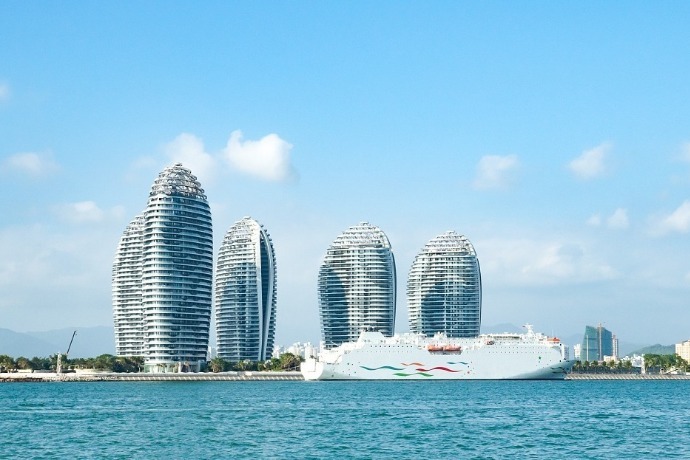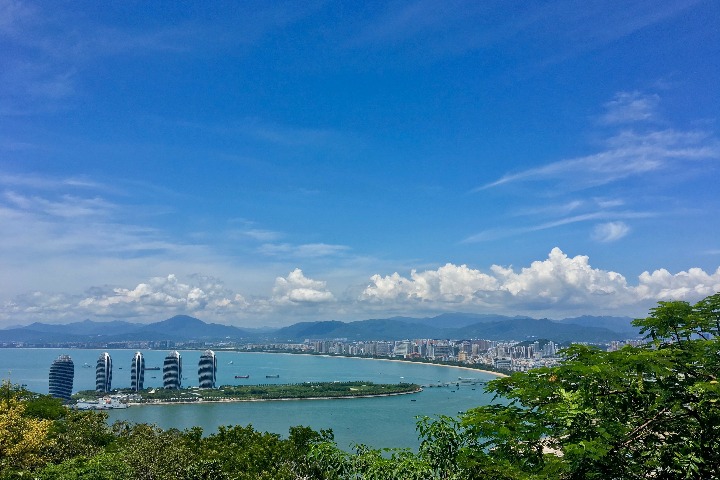Wider cooperation delivering results, generating attractive benefits and wider appeal of the island as an investment destination
An intercontinental ocean shipping container line linking Yangpu Port in the tropical island province of Hainan with ports in African countries opened recently, expanding Yangpu's foreign trade routes and establishing the port as a hub connecting major domestic ports with those in countries in the Association of Southeast Asian Nations, the South Pacific and the Indian Ocean regions, government officials and experts said.
The launch of the new container route was part of Hainan's accelerating efforts to boost high-quality development and make the Hainan Free Trade Port a model for China's reform and opening-up in the new era, provincial government officials added.
They said Hainan, a city connecting China with Southeast Asia, has been hastening construction of Hainan FTP with bold innovative steps for which a master plan was revealed by the central government in June 2020. It aims to turn Hainan island into a free trade port with Chinese characteristics and worldwide influence by the middle of the century.
Wider opening-up is delivering visible results, generating attractive economic benefits and has added appeal to Hainan as an emerging place for investment.
A Haikou-based aviation maintenance company, for instance, recently became the first big beneficiary of the "zero tariff" policy for raw and auxiliary materials granted by the master plan, enjoying about 10 million yuan ($1.38 million) in a tax exemption for importing a spare engine for a Boeing 787, at a value of 90 million yuan.
Hainan Ausca International Oils and Grains in the Yangpu Economic Development Zone, currently a testing ground for Hainan FTP policies, has been exempted from 190 million yuan in tax thanks to the "zero tariff" policy on value-added processing of imported materials. It started business operations in June 2021, according to company managers.
To date, national authorities have issued three "zero-tariff" commodity lists for companies based in Hainan.
They include ships, yachts, automobiles, aircraft, production materials and equipment, and entertainment facilities.
As of August, a total of 11.68 billion yuan worth of "zero-tariff" goods had moved in through Haikou Customs and 2.14 billion yuan of tax was exempted for enterprises, the Haikou Customs reported.
Local officials said that Hainan will soon conduct a comprehensive assessment of the implementation of the current "zero-tariff" commodity lists and consult the central authorities on optimizing and expanding their scope, to enhance cross-border trade facilitation and support high-quality development of foreign trade in the Hainan FTP.
The central authorities have introduced more than 180 policy documents since 2018 to liberalize and facilitate investment and trade in goods and services, and to secure wider market access to sectors including finance, culture and medical care, to make Hainan FTP a showcase of China's economic reform and opening-up, according to government officials. They said the implementation of the policies and the Hainan Free Trade Port Law, which went into effect in June 2021, have helped establish a free trade port system that is characterized by an internationally competitive zero tariff policy, a low tax rate and a simple tax system", promoting the free and convenient flow of trade, investment, cross-border capital and personnel, as well as the safe and orderly flow of data.
The central authorities have also issued a series of policy measures to support quick and high-level development of new offshore international trading in the Hainan FTP. Hainan is actively formulating measures to promote the construction of a comprehensive digital service platform, to attract more market players to settle in Hainan and expand new offshore international trading business models.
Officials from the Hainan provincial department of commerce said they will promote the "zero tariff" policy on value-added processing of imported materials to the whole island, introduce more processing and manufacturing projects and encourage the growth of industrial clusters that involve biomedicine and medical equipment, food processing, new energy and new materials, and high-end equipment manufacturing.
To facilitate a more open, convenient and efficient business environment for traders and investors, Hainan has also made significant headway in the integration of institutional innovations.
To date, a total of 128 institutional integration innovation cases have been completed, in fields such as commercial registration, foreign investment management and trade supervision, of which 120 have been promoted across the province, officials said.
They noted that Hainan FTP has become a strong magnet for both domestic and foreign investment as the province accelerates its opening-up against the backdrop of the global economic slowdown caused by the COVID-19 pandemic.
A total of 1,936 foreign-invested enterprises were established in 2021 in Hainan, an increase of 92.64 percent over 2020.
Foreign trade has been growing for 22 consecutive months, ranking the area fifth nationally in growth rate to reach 125.75 billion yuan from January to August, up 45 percent year-on-year, according to data from the provincial market supervision bureau.
In the first half of the year, a large number of globally famous enterprises such as LVMH, Dun and Bradstreet, Viatris, Iqvia Holdings, Tapestry, Raffles Singapore and Sotheby's have invested in Hainan.
Market entities jumped from around 420,000 in 2012, to 1.98 million by the end of June, indicating that both enterprises inside and outside the country are enthusiastic about investing in Hainan FTP.
Lured by the new offshore duty-free policies updated by the central authorities in 2020, about 1,400 overseas brands have made their debuts and some have opened boutiques in Hainan, which is building itself into an international tourism consumption destination, the authorities said.
Meanwhile, exchanges in international energy, shipping, commodities and carbon trading have been established in the free trade port, which will be the largest in the world when construction is completed.
For a province that used to rely heavily on the real estate sector, Hainan has made full use of free trade port policies to accelerate the construction of a modern industrial system, with tourism, modern services, high-tech industry and highly efficient tropical agriculture as the pillars of the economy.
In 2021, the four leading industries contributed nearly 80 percent of local economic growth. They have become the most important drivers for high-quality economic development in Hainan, said officials.
The province is making full preparations to launch independent customs operations by 2025 as part of broader measures to promote trade and investment liberalization and facilitation, and to better integrate itself into the country's new development paradigm of domestic and international economic circulation, or "dual circulation", they said.
Independent customs operations mean a wider and deeper opening-up of the Hainan FTP to the world, officials said.





